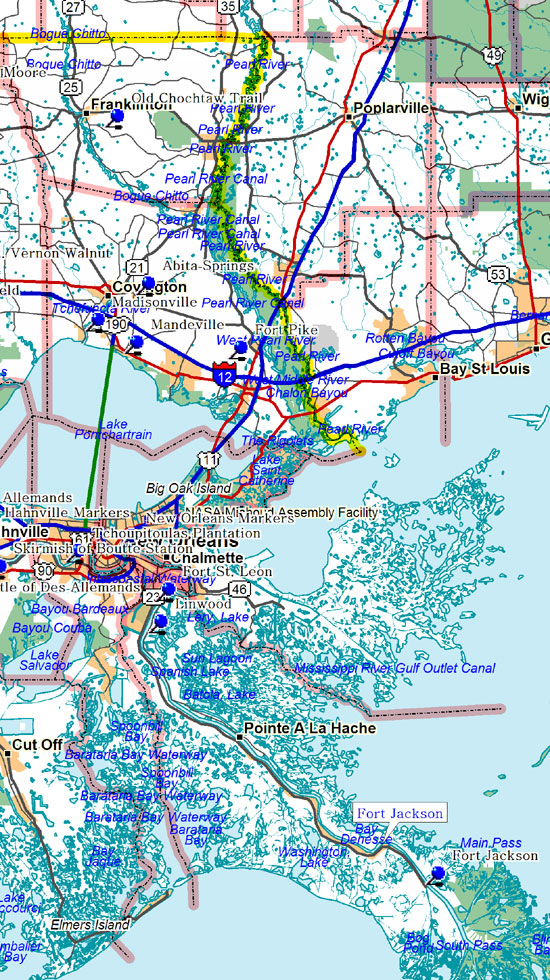|
||||
|
|
||||
JeffersonTchoupitoulas PlantationSite of plantation acquired in 1808 by Joseph Soniat du Fossat. Visited by Governor William C. C. Claiborne and, legend says, privateer Jean Lafitte. Chapitoulas Indians, whose name means river people, lived in this area. Located in Harahan, District 2, Hwy 48, Jefferson Parish. OrleansFort St. CharlesOn October 25, 1769, under General O’Reilly, Spanish Governor of Louisiana, were executed French patriots and martyrs: de Lafreniere, Marquis, Noyan, Caresse, Milhet, Villere having died previously. Located in New Orleans, LA, Dist. 2, Esplanade Street, Orleans Parish. Fort St. John Spanish FortEstablished by Colonial French in the early 18th century. Rebuilt by the Spanish - 1779. American restoration - 1808. Built to protect New Orleans from attack by way of Lake Pontchartrain. Located in New Orleans, LA, Dist. 2, Between Robert E. Lee and Lakeshore, Orleans Parish. Lake PontchartrainTraveled on by Iberville, 1699 and named for the French minister of Marine. Indians called it Okwa-ta, wide water. First port of embarkation was at the site where bayou St. John flows from this lake. It was the first water route to the city of New Orleans. Located in New Orleans, District 2, St. Bernard and Lakeshore Ave., Orleans Parish. New OrleansFirst sited as Indian portage to Lake Pontchartrain and Gulf in 1699 by Bienville and Iberville. Founded by Bienville in 1718; named by him in honor of the Duke of Orleans, Regent of France. Called the Crescent City because of location in bend of the Mississippi. Located in New Orleans, District 2, City Park, Orleans Parish. Vieux CarrÈ FortsSite of Fort St. Louis, Upstream Bastion of New Orleans, founded 1717 by Bienville and laid out by Adrien de Pauger. Other Forts: St. Charles, St. Jean, St. Ferdinand, and Burgogne. Located in New Orleans, LA, Dist. 2, Canal Street, Orleans Parish. PlaqueminesFort JacksonBuilt around 1822-32 to protect the lower river. Named for Andrew Jackson. 1862 - Fort withstood 10 day siege by Farragut and surrendered after city fell. In 1898 and 1917-18 used as training base. 1961-Fort was declared a national monument. Located in Venice, District 2, Hwy 23 Plaquemines Parish. Fort St. LeonDesigned by De Verges and garrisoned in 1754, but abandoned in 1792. Because of strategic value it was rebuilt by Latour in 1808 and garrisoned to defend New Orleans; Destroyed by Adm. Farragut during Civil War in advance up river. Located in Belle Chasse, District 2, River Road, Parish. Plaquemines Parish. St. CharlesBattle of Des AllemandsLe district des Allemands, settled by Germans about 1720, the scene of numerous skirmish resulted in capture of an entire detachment of Union soldiers on September 4, 1862. Located in Des Allemands, LA, Dist. 2, Hwy 90, St. Charles Parish. Fashion PlantationHome of General Richard Taylor, son of Zachary Taylor, Louisiana Statesman, and member of 1861 Secession Convention. Commanded Louisiana district, 1862-64; defeated Banks at battle of Mansfield, 1864. Federals plundered home in 1862. Located in Hahnville, LA, Dist. 2, Hwy 18, St. Charles Parish. FlagvilleNamed for O.J. Flagg, 1870. Now a part of Hahnville. Letter left here by Tonti, 1686 with Quinipissa Chief for LaSalle. Taensa Village, 1713. De Meuve, French Concession, 1718. Site included grant to Joseph Roi de Villere, 1765. Located in Hahnville, LA, Dist. 2, Hwy 18, St. Charles Parish St. Charles Parish. Les AllemandsAkanca Indian land prior Karlstein. Site of first German villages 1719-1722 and St. Jean des Allemands Chapel. Settlers joined in 1768 revolt against Spain. Leaders, Chevalier Karl d’Arensbourg and Captain Joseph Roi De Villere who was first martyr in 1769. Located in Killona, LA, Dist. 2, Five miles above Hahnville on the West Bank of the Mississippi River, St. Charles Parish. Skirmish of Boutte StationUnion train with sixty men ambushed by Confederate force of Louisiana militia and volunteers on September 4, 1862. Train escaped to New Orleans. Fourteen Union soldiers killed and twenty-two wounded in the skirmish. Located in Boutte, District 2, St. Charles Parish. St. TammanyAbita SpringsOld Choctaw village which derived name from nearby medicinal springs. Last Choctaw burial and execution grounds, used until about 1880, located nearby. Located in Abita Springs, District 62, State Park, Hwy 58, St. Tammany Parish. Fort PikeHistoric State monument ten miles west on US 90, was completed in 1828 to defend Rigolets Pass, approach through Lake Pontchartrain to New Orleans. Named after Brigadier General Zebulon Montgomery Pike. Located near Slidell, LA, District 2, Hwy 11, St. Tammany Parish. MadisonvilleOriginally called Cokie (from Coquille) because of the abundance of shells in the area. Renamed for President James Madison, c. 1811. Site of Navy Yard in early 1800"s. According to legend Gen. Andrew Jackson, enroute to New Orleans in Nov. 1814 stopped here at the home of Gen. David B. Morgan. Located in Madisonville, District 62, Walter Street, St. Tammany Parish. MandevilleNamed for Pierre Philippe de Marigny de Mandeville, landowner during the late seventeen hundreds. Near this site Bienville met, in 1699, Acolapissas who reported that, two days before, their village had been attacked by two Englishmen and 200 Chicasaws. English were rivalling the French for this area. Located in Mandeville, District 62, Along Lake Pontchartrain, St. Tammany Parish. WashingtonOld Choctaw TrailOnly official state road in Washington Parish until 1843. Choctaw Indians cut trail for trade with tribes in Baton Rouge, New Orleans, Biloxi, and Mobile. White man believed to have used trail as early as 1542. Located in Franklinton, LA, Dist. 62, Washington Parish. |
||||
|
||||
